GMC (automobile)
General Motors Truck Company (GMC), formally the GMC Division of General Motors LLC, is a division of the American automobile manufacturer General Motors (GM) that primarily focuses on trucks and utility vehicles. GMC currently makes SUVs, pickup trucks, vans, and light-duty trucks, catered to a premium-based market. In the past, GMC also produced fire trucks, ambulances, heavy-duty trucks, military vehicles, motorhomes, transit buses, and medium duty trucks.
The GMC logo used since 1966 | |
| Type | Division LLC |
|---|---|
| Industry | Automotive |
| Predecessors | Rapid Motor Vehicle Company Reliance Motor Car Company |
| Founded | July 22, 1911 |
| Founder | William C. Durant |
| Headquarters | , |
Area served |
|
| Products | Automobiles Commercial vehicles Trucks |
| Parent | General Motors |
| Divisions | Hummer |
| Website | gmc.com |
While many GMC and Chevrolet trucks are mechanically identical, GMC is positioned as a premium offering to the mainstream Chevrolet brand, with luxury vehicles such as the Denali series. In North America, GMC vehicles are almost always sold alongside Buick vehicles at joint dealerships, allowing the same dealer to market both upscale cars and trucks.
History
.jpg.webp)
GMC traces its history to the 1902 founding of the Rapid Motor Vehicle Company in Pontiac, Michigan. In 1909 William C. Durant gained control of Rapid Motor Vehicle Company and made it a subsidiary of his General Motors Company. In 1908 Durant gained control of Reliance Motor Car Company, another early commercial vehicle manufacturer. In 1911 General Motors formed the General Motors Truck Company and folded Rapid and Reliance into it. In 1912 the Rapid and Reliance names were dropped in favor of “GMC.” All General Motors truck production was consolidated at the former Rapid Motor Plant 1 in Pontiac, Michigan.[1]
GMC maintained three manufacturing locations in Pontiac, Michigan, Oakland, California, and St. Louis, Missouri.
In 1916, a GMC Truck crossed the country from Seattle to New York City in thirty days, and in 1926, a 2-ton GMC truck was driven from New York to San Francisco in five days and 30 minutes. During the First World War, the company provided the Model 16 3/4-ton truck,[2] and modified its production to provide 1-ton troop carriers and aviation support vehicles, and by 1918, more than 90 percent of GMC truck production was for military use. GMTC provided a total of 8512 trucks to the U.S. government during the war years and earned a Distinguished Service Award.[3] During the Second World War, GMC Truck produced 600,000 trucks for use by the United States Armed Forces.
In 1923, GMC trucks were exported to Japan to help recovery and reconstruction as a result of the Great Kantō earthquake, and the company continued to provide vehicles as the transportation infrastructure was rebuilt. Before the earthquake struck, most of Japan's transportation of commerce and people was by wooden carts and government owned railroads, which were severely damaged when the train tracks were twisted beyond use. Autonomous trucks were much more effective at traveling to heavily damaged areas.[4]
In 1925, GM purchased a controlling interest in Yellow Coach, a bus and taxicab manufacturer based in Chicago, Illinois which was founded by John D. Hertz. The company was renamed Yellow Truck & Coach Manufacturing Company (YT&CMC), an affiliated subsidiary of General Motors. All manufacturing operations of General Motors Truck Company were placed under YT&CMC. In 1928 Plant 2 opened and all headquarters staff moved to the administration building at 660 South Boulevard E in Pontiac, MI. In 1943, GM purchased the remaining interest in YT&CMC and renamed it GMC Truck and Coach Division.[5]
In 1981, GMC Truck & Coach Division became part of GM Worldwide Truck & Bus Group. Bus production ended in May 1987 and the division name was changed from GMC Truck & Coach to GMC Truck Division. The Canadian plant (in London, Ontario) produced buses from 1962 until July 1987. GM withdrew from the bus and coach market because of increased competition in the late 1970s and 1980s. Rights to the RTS model were sold to Transportation Manufacturing Corporation, while Motor Coach Industries of Canada purchased the Classic design.[6] In 1998, GMC's official branding on vehicles was shortened from "GMC Truck" to simply "GMC".
In 1996, GM merged GMC Truck Division with the Pontiac Motor Division in order to "give the combined division a brand image projecting physical power and outdoor activity".[7] This coincided with many GMC dealerships merging with Pontiac dealerships, allowing a single dealer to offer both trucks and entry-to-mid-level cars, using a similar approach already in use by Chevrolet.
In 2002, GMC celebrated its 100 anniversary and released a book entitled GMC: The First 100 Years, a complete history of the company.
In 2007, GMC introduced the Acadia, a crossover SUV, which was the division's first unibody vehicle whose predecessor, the GMT-360 based Envoy, was discontinued with the closure of GM's Moraine, Ohio plant on December 23, 2008.
In 2009, GMC ended production of medium-duty commercial trucks after over 100 years.[8] They became exclusive to Chevrolet with the launch of the 4500HD/5500HD Silverado in 2018.[9] Also in 2009, GMC introduced the Terrain, a mid-size crossover SUV based on the GM Theta platform shared with the Chevrolet Equinox. It replaced the Pontiac Torrent after the brand's demise.
On January 30, 2020, General Motors released a series of short teaser videos revealing the return of Hummer nameplate, this time as a sub-brand of GMC instead of a stand-alone division.[10] The short spots tease a 30-second Super Bowl ad featuring NBA superstar LeBron James. The teasers confirm the nameplate's return—this time not as an independent franchise, but as two models, an electric pickup truck and SUV, to be sold as the "GMC Hummer EV.". According to the teasers, the production EV will feature 1,000 horsepower, hit 60 mph in 3 seconds and is scheduled to launch in late 2021. While the new Hummer EV was scheduled to be revealed on May 20, 2020, concerns over the COVID-19 pandemic forced the revealing to be pushed back until October 20th, 2020.
Platform sharing with Chevrolet
Beginning in 1920, GMC and Chevrolet trucks became largely similar, built as variants of the same platform, sharing much the same body sheetwork, except for nameplates and grilles – though their differences, especially engines, have varied over the years. GMC advertising marketed its trucks to commercial buyers and businesses, whereas Chevrolet's advertising was directed towards private owners. Beginning in 1928, GMCs used Pontiac's 186 cu in six-cylinder engines in their lighter trucks.[11] Medium-duty trucks relied on Oldsmobile straight-6 engines, while the heaviest trucks used GMC's own "Standard Big Brute" engine.[11] From 1939 to 1974 GMC had its own line of six-cylinder engines, first the inline sixes known as "Jimmy's" from 1939 to 1959, and then their own V6 from 1960 until 1974, of which a V8 and a V12 version also existed. Additionally, from 1955 through 1959, the less than 2-ton, domestic GMC gasoline trucks were equipped with Pontiac, Buick, and Oldsmobile V8s—whereas the Canadian models used Chevrolet engines.
Between 1962 and 1972, most GMC vehicles were equipped with quad-headlights, while their Chevrolet clones were equipped with dual-headlights.
In 1971, GMC marketed their version of the Chevrolet El Camino, which was based on the Chevrolet Chevelle. Called Sprint, it was virtually identical to the El Camino, and a sport version, the SP, was equivalent to the El Camino SS.
In 1973, with GM's introduction of the new "rounded line" series trucks, GMC and Chevrolet trucks became even more similar, ending production of GMC's quad-headlight models, and setting the standard for the Chevrolet/GMC line of trucks for over thirty years.
As of 2020, GMC's vehicles are marketed as more premium, luxury vehicles positioned above similar vehicles from the more mainstream Chevrolet division. Chevrolet vehicles are priced lower than a comparable GMC, but GMC vehicles have features not found in a comparable Chevrolet.[12]

In North America, Chevrolet offers a full lineup of cars, crossover vehicles, sport utility vehicles, and pickup trucks. GMC, however, does not offer any car models, so typically they are sold along Buick (or sometimes Cadillac) vehicles at joint dealerships, allowing the same dealer to sell a full lineup of upscale vehicles, including both cars and trucks. However, standalone GMC dealerships do exist, primarily for dealers who have a focus on selling to the commercial and fleet vehicle markets.
GMC models
Light-duty trucks
| Image | Model | Introduced | Discontinued | Notes |
|---|---|---|---|---|
.jpg.webp) |
T and F series | 1937 | 1938 | Similar to the Chevrolet G/S and F/T series |
 |
AC and AF series | 1939 | 1940 | AF series is cabover design |
 |
C and E series[13] | 1941 | 1947 | Little different from the Chevrolet Art Deco trucks |
.jpg.webp) |
New Design series | 1947 | 1955 | Little different from the Chevrolet Advance-Design trucks |
.jpg.webp) |
Blue Chip series | 1955 | 1959 | Pontiac Powered, similar to the Chevrolet Task-Force trucks |
 |
C and K Series | 1960 | 1998 | half–, three-quarter– and one-ton trucks, with Sierra, Sierra Grande, High Sierra, and Sierra Classic trim lines |
.jpg.webp) |
Sprint | 1971 | 1977 | Coupe utility – GMC version of the 1971 to 1977 Chevrolet El Camino |
 |
Caballero | 1978 | 1987 | Coupe utility – GMC version of the 1978 to 1987 Chevrolet El Camino |
.jpg.webp) |
S-15 | 1982 | 1990 | Became the Sonoma in 1991 |
 |
Sonoma | 1991 | 2004 | Formerly the S-15 1982–1990 |
 |
Syclone | 1991 | 1991 | High performance version of the Sonoma |
 |
Sierra | 1988 | current | GMC version of Chevrolet C/K (1988–99) Chevrolet Silverado (1999-present) medium- and heavy-duty pickup |
.jpg.webp) |
Canyon | 2004 | current | GMC version of Chevrolet Colorado midsize pickup |
| Hummer EV SUT | 2021 | current | General Motors' first all-electric off-road pickup |
Medium-duty trucks
| Image | Model | Introduced | Discontinued | Notes |
|---|---|---|---|---|
 |
Varies, first letter denotes production year: A=1939-1940, C=1941-1945, E=1946, F=1947-1950, Z=1954, Y=1955, X=1956, T=1957, S=1958-1959, N=1960; Second letter denotes cab style: C=cab behind engine, F=cab over engine | 1939 | 1959 | Line sold to Navistar, now marketed under the WorkHorse brand. |
.jpg.webp) |
L-Series | 1960 | c.1984 | Steel Tilt Cab |
 |
TopKick | 1980 | 1996 | |
 |
C-Series | 1960 | 2009 | |
 |
Forward | 1980s | 2010 | rebadged Isuzu Elf |
 |
W-Series | 1984 | 2010 | Rebadged Isuzu Elf |
 |
T-Series | 1994 | 2010 | Rebadged Isuzu Giga |
.jpg.webp) |
TopKick | 2003 | 2009 | Model used for Ironhide in the Transformers film series |
Heavy-duty trucks
| Image | Model | Introduced | Discontinued | Notes |
|---|---|---|---|---|
.jpg.webp) |
DLR/F/“Crackerbox” | 1959 | 1968 | Aluminium Tilt Cab |
| B-Model | 1960 | 1966 | ||
.jpg.webp) |
7500 | 1963 | 1978 | |
.jpg.webp) |
9500 | 1966 | 1978 | |
 |
Astro 95 | 1968 | 1988 | |
 |
General | 1977 | 1988 | |
 |
Brigadier | 1978 | 1988 |
Buses
| Image | Model | Introduced | Discontinued | Notes |
|---|---|---|---|---|
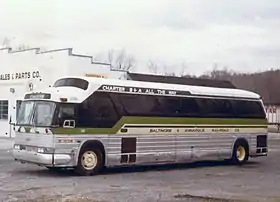 |
P-series[14] | 1940s[15] | 1980 | "Parlor" (highway) coaches |
 |
"Old Look" | 1940[15] | 1969 | transit |
 |
"New Look" | 1959 | 1986 | transit |
 |
RTS | 1977 | 1987 | transit |
 |
Classic | 1982 | 1987 | transit |
 |
B-series | 1966 | 2003 | school bus |
| S-series | 1986 | 1989 | school bus (forward control) |
Vans
| Image | Model | Introduced | Discontinued | Notes |
|---|---|---|---|---|
.jpg.webp) |
Handi-Van | 1964 | 1970 | |
 |
Handi-Bus | 1964 | 1970 | |
 |
Rally | 1970 | 1996 | GMC version of the Chevrolet Sportvan |
 |
Vandura | 1970 | 1996 | GMC version of the Chevrolet Chevy Van |
 |
Safari | 1985 | 2005 | GMC version of the Chevrolet Astro |
 |
Savana | 1996 | current | GMC version of the Chevrolet Express |
SUVs
| Image | Model | Introduced | Discontinued | Notes |
|---|---|---|---|---|
 |
Suburban | 1937 | 2000 | Rebranded as Yukon XL, it was sold in middle east with Suburban nameplate beside the Yukon XL, until 2007 |
.jpg.webp) |
Jimmy | 1969 | 1995 | GMC version of the Chevrolet Blazer |
 |
S-15 Jimmy | 1983 | 2005 | GMC version of the Chevrolet Blazer |
| Tracker | 1989 | 1991 | Canada only, GMC version of the Geo Tracker | |
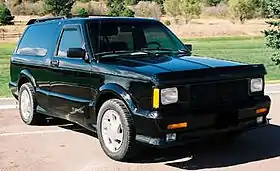 |
Typhoon | 1992 | 1993 | High performance version of the S-15 Jimmy |
 |
Yukon | 1992 | current | GMC version of the Chevrolet K5 Blazer (1992-1995) and Chevorlet Tahoe (1995–present) |
 |
Envoy | 1998 | 2009 | GMC version of the Chevrolet TrailBlazer |
 |
Yukon Hybrid | 2009 | 2013 | GMC version of Chevrolet Tahoe Hybrid and Cadillac Escalade Hybrid |
 |
Yukon XL | 2001 | current | Formerly the Suburban |
 |
Acadia | 2007 | current | GMC version of the Chevrolet Traverse; became a mid-size crossover SUV commencing with the 2017 model year |
 |
Terrain | 2010 | current | GMC version of the Chevrolet Equinox |
| Hummer EV SUV | 2021 | current | Sport Utility variant of the electric Hummer EV off-road sub-brand |
Motorhomes
| Image | Model | Introduced | Discontinued | Notes |
|---|---|---|---|---|
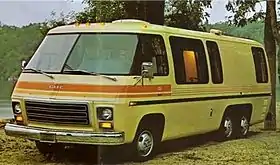 |
GMC motorhome | 1973 | 1978 |
Military vehicles
| Image | Model | Introduced | Discontinued | Notes |
|---|---|---|---|---|
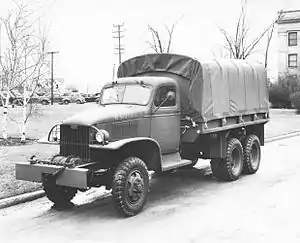 |
CCKW/CCW | 1941 | 1945 | |
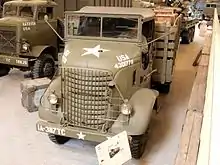 |
AFKWX | 1941 | 1945 | Cab over engine |
 |
DUKW | 1942 | 1945 | Amphibious |
Sedans
| Image | Model | Introduced | Discontinued | Notes |
|---|---|---|---|---|
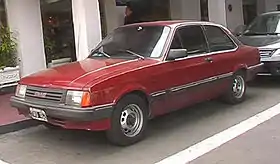 |
Chevette | 1992 | 1995 | Rebadged Chevrolet Chevette intended for the Argentinian market |
See also
References
- "The First Century of GMC Truck History" (PDF). GM Heritage Center. Donald Meyer. Retrieved 18 September 2018.
- "Vintage truck models of GMC". The Vintage News. Retrieved 20 September 2020.
- "GMC's Centennial 1921-2012". Motortrend. Motor Trend Group LLC. Retrieved 20 September 2020.
- Yanase opened Japan to Western cars, Automotive News, March 31, 2008
- Theobald, Mark. "Yellow Coach Part 1". Coachbuilt. Coachbuilt. Retrieved 18 September 2018.
- Stauss, Ed (1988). The Bus World Encyclopedia of Buses. Woodland Hills, CA: Stauss Publications. pp. 29–32, 87, 102–105. ISBN 0-9619830-0-0.
- Bradsher, Keith (February 20, 1996). "G.M. to Merge GMC Division With Pontiac". New York Times.
- "GM Getting Out of Medium-Duty Truck Business". NBCNews.com. Associated Press. Retrieved 18 September 2018.
- No Plans For GMC Versions Of 2019 Silverado 4500HD, 5500HD Medium Duty Truck from GM Authority (January 22, 2018)
- Paukert, Chris. "Hummer's electrifying return teased in GMC Super Bowl trailer". Roadshow. Retrieved 2020-01-30.
- Stromberg, Austin W., ed. (January 1928). "New GMC Six Has Pontiac Engine". Power Wagon. XL (277): 64.
- Hemer, Chris (November 28, 2019). "First Look: 2020 GMC Sierra HD". Trailer Life.
- "A Brief Outline of the First Century of GMC Truck History". GM Heritage Center. Archived from the original on 9 July 2015. Retrieved 5 February 2015.
- "List of GM PD Series Parlor Coaches".
- produced by Yellow Coach 1940–43
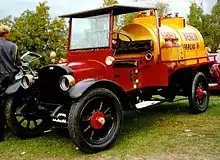
.jpg.webp)
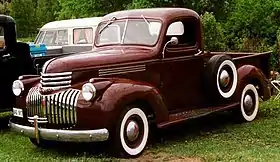
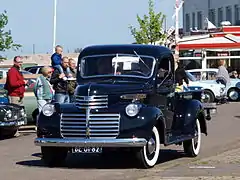


.svg.png.webp)